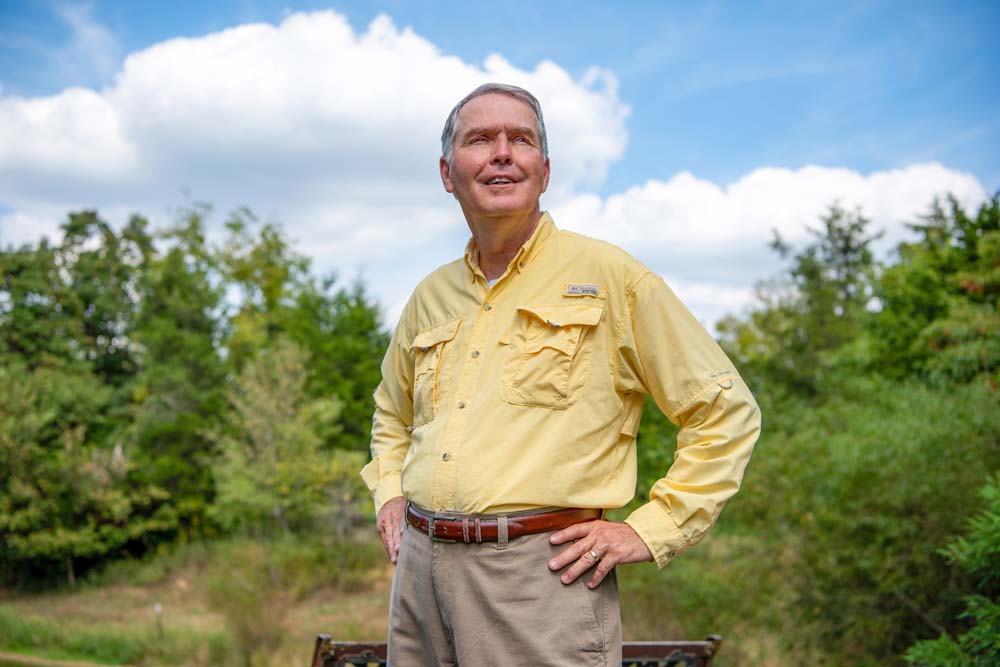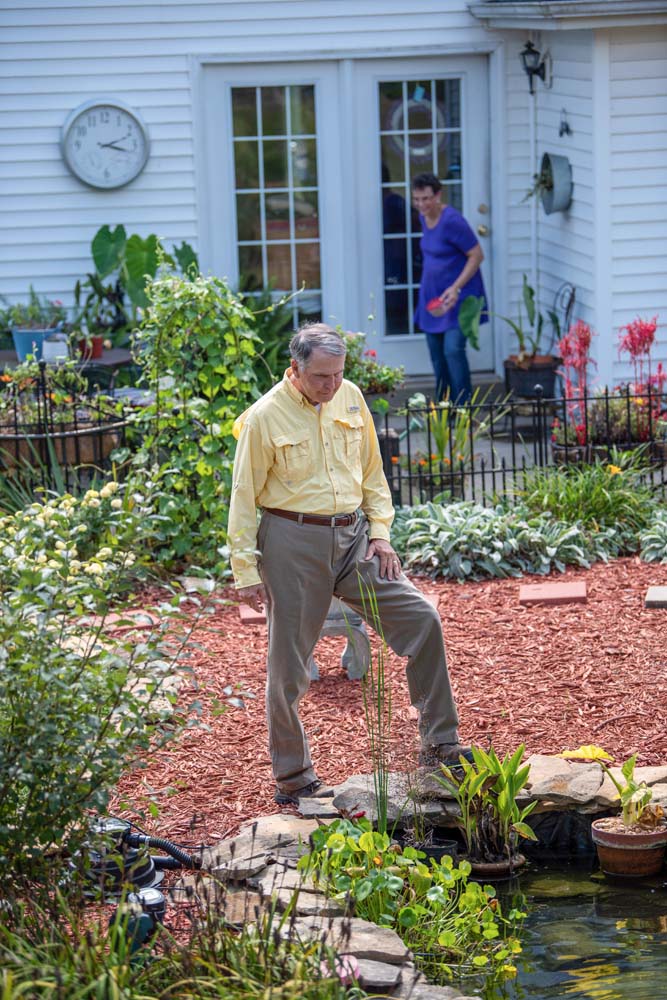Fighting to Remember: Alzheimer’s
Searching for a cure, learning to cope
Paul Hornback’s Alzheimer’s journey began when the numbers stopped adding up.
For this former United States Marine helicopter pilot turned engineer, numbers, mathematics, had been his professional stock in trade for decades. Then, in his mid-50s, “I started having trouble doing calculations. I couldn’t remember formulas,” he says.

Soon, he couldn’t multitask. He and his wife, Sarah, spent 18 anxious months consulting doctors, trying to find a diagnosis. “Some days a fog rolled in his brain and he couldn’t see through it,” Sarah says.
Then, a brain scan revealed the answer they’d dreaded: Alzheimer’s disease—which is terminal and incurable.
“I was probably the only woman in the world praying her husband had a brain tumor,” Sarah says. “Because you can beat a brain tumor.”
Ten years later, the Hornbacks, who live in Hodgenville and are consumer-members of Nolin RECC, are perpetually adjusting to a new normal as Paul’s disease progresses. He is among the 71,000 Kentuckians facing Alzheimer’s, which costs the state over $720 million a year in health care expenses, though its emotional toll on people who have the disease, as well as their families, is incalculable.
November is National Family Caregivers Month and National Alzheimer’s Disease Awareness Month. At Kentucky Living, we wanted to take a look at how Alzheimer’s is impacting Kentucky families and learn about the work happening around the state (and beyond) to fight the epidemic.
The closest thing to good news for Alzheimer’s sufferers and their families is that more people than ever are mobilizing to fight the disease. Researchers in Kentucky and around the world are working hard to find a cure, supported by families and loved ones of Alzheimer’s patients, and in some cases, the patients themselves.
Alzheimer’s is a degenerative disease that attacks the brain and gradually leads to dementia and death. It was first diagnosed in 1906 by German scientist Alois Alzheimer, who identified the causes of memory loss and behavioral symptoms in a woman who died at 55. The cause was an excessive amount of proteins in the brain known as tau and beta-amyloid (also referred to as amyloid beta). When those proteins build up —and the reasons this happens aren’t entirely clear—the brain’s neural network breaks down.

Think of your brain like a series of landline telephone wires. When they’re working properly, all the signals follow set paths, carrying information from one point on the network to the other. Now picture, say, a tornado or an earthquake, some force that rips some poles out of the ground, twisting wires and crossing signals, destroying some connections entirely, and sending others to the wrong destination.
Over a period of years, Alzheimer’s produces a similar effect in the brain, leading to confusion and memory loss. As the disease progresses, it produces massive cell death across both hemispheres of the brain, shrinking the brain and gradually eliminating speech, motor function and cognitive processes; muscle, bladder and bowel control; and eventually stopping even breath and heartbeat.
Alzheimer’s, or some other form of dementia, is affecting an increasing number of Americans. According to the Alzheimer’s Association, between 2000-2017, while heart disease deaths decreased, Alzheimer’s-related deaths increased 145%. Nationwide, 5.8 million people have been diagnosed with the disease and that number is expected to more than double by 2050.
Left unchecked, “This disease is going to bankrupt the country by 2050 due to the cost of care,” says Donna Wilcock, a professor of physiology at the University of Kentucky Sanders-Brown Center on Aging. Alzheimer’s and other forms of dementia cost Americans about $290 billion in 2019. By 2050, that number could reach $1.1 trillion.
One key to reversing that trend is finding a breakthrough in treatment. Like many scientists, Wilcock sees possibility: “I think we can move the needle by 2025.”
She’s not talking about a cure, not yet, or even a way to extend a person’s lifespan. What’s almost within scientific reach is a way to potentially delay the onset of symptoms. “The goal is to give the maximum quality of life and then, when it’s time, for the process to be quick and painless,” Wilcock says.
Progress starts with funding
To produce those breakthroughs that Wilcock cites, scientists and research centers need funding, and advocating for federal support for funding has become a passion for Greg Gilbert.
A registered nurse at the Paul E. Patton Eastern Kentucky Veterans Center in Hazard, he has worked in long-term care for 23 years and seen more than 1,000 people grapple with Alzheimer’s, including his own grandmother. “We had to disconnect the battery in her car so she wouldn’t drive off,” he says.
In dealing with Alzheimer’s patients, Gilbert says, “You have to give them the love and compassion they deserve, but know that they’re not going to win.” It frustrates him how little health professionals and loved ones can do for people suffering from Alzheimer’s. “That’s what gives us the fire in our bellies—those of us who work on the advocacy side,” he says.
In partnership with the Alzheimer’s Association and other groups, Gilbert has met with members of Kentucky’s congressional delegation, including Kentucky’s Rep. Hal Rogers, who represents the 5th District, to urge the federal government to increase funding for Alzheimer’s research. Those efforts have led to more federal dollars going to research through the National Institutes of Health, which is spending more than $2 billion studying Alzheimer’s in 2019.
Alzheimer’s advocates say much more is needed to find a cure, which is why private donations also are important, like the millions of dollars raised from Walk to End Alzheimer’s events held throughout Kentucky and the U.S. every year.
Kimberly Fondaw of Paducah has raised money through numerous Alzheimer’s walks in honor of her late mother, who died of the disease 15 years ago. “She was very childlike; it was hard to even get her dressed,” remembers Fondaw, a consumer-member of Jackson Purchase Energy. “The hardest part was she knew me as her grown daughter but didn’t remember my childhood.”
Fondaw made a promise to her mom “that we would keep fighting” for a cure. Over the last four years, Fondaw and a group of her Walmart co-workers have been fundraising champions in the Purchase Area Walk to End Alzheimer’s. Last year, her team had 60 members and raised $20,000.
She’s also advocated for more federal funding, working with U.S. Rep. James Comer’s office. The cause is worth the effort, she says, because even though people associate Alzheimer’s with older folks, “Really, it affects everybody.”
Effects on caregivers
The families of people with Alzheimer’s often face daunting challenges of their own. In addition to legal and financial concerns (see sidebar on page 32), there are serious logistical and emotional impacts for caregivers, often spouses or children who find themselves in the uncomfortable position of having to essentially parent their own parents.
Kim Croley is a pharmacist at Laurel Senior Living Communities in London, and she also runs a support group for Alzheimer’s caregivers. “They always want to know, ‘Is there a medicine that fixes this?’’’ Croley says, “And there’s not.”
There are medicines that can reduce symptoms, at least for a while, but eventually the disease overwhelms the medicine, the patient and often the caregivers. “We try to help them answer questions like, ‘How do I get them to bathe?’” Croley says. “Or, ‘How do I get them out of the car once they get in?’”
She says the hardest behaviors for caregivers to deal with typically involve “swearing, nudity and incontinence.”
Croley’s group members are mostly women, but men show up as well, some of whom are new to the role of caregiver. “Most of my gentlemen are in their 70s and 80s and they’re overwhelmed because they’ve never had to deal with all the cooking and the laundry and keeping up with the doctors’ appointments and everything.”
In the group, Croley says she emphasizes the importance of caregivers caring for themselves and of finding solace in others who understand their challenges. “We let people talk. And if they cry, we give them tissue and hug their neck,” she says.
The long goodbye
There are few mercies in Alzheimer’s, but one is that the disease moves slowly. According to the Mayo Clinic website, “On average, people with Alzheimer’s disease live between three and 11 years after diagnosis, but some survive 20 years or more.”
Paul and Sarah Hornback continue working to adapt, adjusting their expectations about what’s possible and what’s necessary, as Paul’s disease progresses.

“As I lose certain abilities, I focus on what I can do,” he says. He can’t drive anymore, work with power tools or do higher math, but Paul can still garden and mow the lawn, and he’s discovered a passion for writing. He’s given speeches as an Alzheimer’s advocate, started a blog (Faithful Foggy Living), finished one book manuscript and is working on more.
“I’m trying to do something positive,” he says. “Self-pity is counterproductive.”
Sarah says that for Paul and many others with Alzheimer’s, “Finding that other thing is vital. Those who have or develop hobbies are much better able to handle living with the disease.”
Sarah is facing double duty as a caregiver—her 84-year-old mother is in the latter stages of Alzheimer’s and has recently moved in with them. Of the prevalence of Alzheimer’s—in America, and her own home—Sarah says, “It’s a little bit disturbing,” but she’s learned to make the best of it. “I cried every day for a year,” she says, “But God shook me and said, ‘You are ruining what time you have left.’”
In fact, for everything Alzheimer’s has taken from the Hornbacks, as it has so many families, it also has drawn them closer together, Sarah says, and offered a bittersweet lesson: “You think you have forever, then you realize you just have today.”
General Information
These websites offer a wealth of information about Alzheimer’s, including explanations of the disease, symptoms, research, support and local resources:
Alzheimers.net, the Alzheimer’s online community
VeryWell Health’s brief guide for choosing an Alzheimer’s doctor, including information about different kinds of specialists.
For Caregivers
Tips for communicating with people with Alzheimer’s during the early, middle and late stages of Alzheimer’s disease.
The Best Friends Approach is widely used in nursing homes as a method of interacting with Alzheimer’s sufferers to offer the most respect and create the least distress. This approach was developed by people working at the University of Kentucky.
The 5 Fundamentals of Caring for Someone with Dementia
In this video, actor and producer Seth Rogen speaks to the U.S. Senate Appropriations Subcommittee on Labor, Health & Human Services about his personal experience of loving someone with Alzheimer’s.
Research
This article from Psychology Today gives information about how dogs are being used to assist people with memory loss.
This short video from The Economist explains Alzheimer’s disease, why it’s been hard to find a cure and promising new research.
Prevention
In this 2017 Ted Talk video, Lisa Genova, neuroscientist and author of Still Alice, discusses what you can do to build an Alzheimer’s-resistant brain.
Harvard Health, a publication of Harvard Medical School, offers tips on avoiding Alzheimer’s.
A recent study points to five steps you can take that may make you less susceptible to Alzheimer’s.
Big Blue breakthrough
Researchers at the University of Kentucky Sanders-Brown Center on Aging are among the many scientists worldwide working overtime to find ways to fight Alzheimer’s disease. In doing so, they’re working to build on a legacy of groundbreaking work in the field.
In 2001, then-UK professor David Snowdon published a 15-year neurological study of 678 nuns, which became known as The Nun Study, and brought new insights into the aging brain. From the May 7, 2001 New York Times: “The Nun Study has certainly been pioneering,” said Dr. Richard Suzman, chief of demography and population epidemiology at the National Institute on Aging. “It’s helped change the paradigm about how people think about aging and Alzheimer’s disease.”

